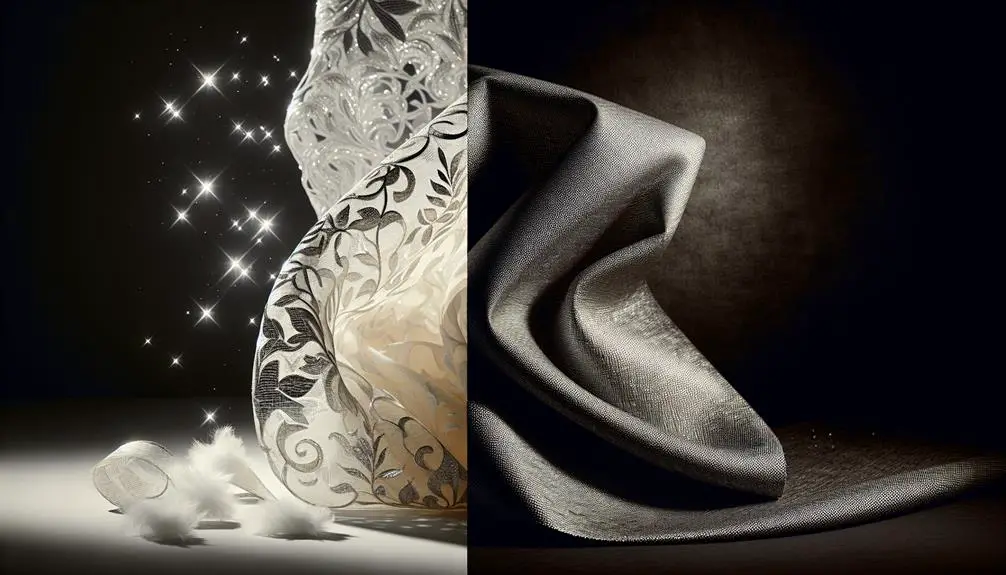So, you're wondering if organza is a pricey fabric, huh? Well, it kinda depends on what type you're looking at. If you go for the silk organza, yeah, it can get pretty expensive. That's mostly 'cause silk is more luxurious and less common. On the other hand, synthetic organza, like polyester or nylon, is way cheaper and still looks pretty good. These types usually resist shrinking and wrinkles, which is a bonus. So, if you're not super set on silk, you can definitely find some budget-friendly options. And if you stick around, you might just find out how to score the best deals on them.
Table of Contents
Key Takeaways
- Pure silk organza is pricier due to its natural fiber content and limited availability.
- Synthetic organza varieties like polyester and nylon are more affordable and durable.
- The cost of organza can vary based on the type of weave and additional finishes applied.
- Geographic location impacts pricing; silk organza costs less in regions with silk production.
- Seasonal demand, such as during weddings and holidays, can temporarily increase organza prices.
Understanding Organza Fabric
Organza is a thin, sheer fabric that's both crisp and flowy, making it super popular for fancy dresses and décor. You know, it's that kind of material that has a slight stiffness but still manages to drape beautifully. It's often used in layers to create a fuller effect without being too heavy, which is perfect for those voluminous wedding dresses or elegant evening gowns.
The unique texture of organza comes from the way it's made. It's typically woven from silk, though modern versions also use synthetic fibers like polyester or nylon, which can affect both its feel and cost. What's really cool is how organza manages to hold shapes well. Think of those intricate ruffles and waves you often see in high-fashion outfits; that's organza working its magic.
Another thing I find fascinating is its sheer quality. It allows for a play of light and shadow on the fabric, giving garments a sort of ethereal look. This sheer nature also means you often see organza used in layers or as an overlay, adding depth and dimension without the bulk. Honestly, it's a designer's dream for creating textures and silhouettes that stand out.
Types of Organza Available
So, let's talk about the different types of organza you can find.
First up, we've got silk organza, known for its sheer, crisp quality.
Then there are synthetic versions which are often more affordable, and don't forget about the organza blends that mix different fibers together.
Silk Organza Characteristics
Silk, one of the most luxurious fabrics, is transformed into various types of organza, each with unique characteristics. Let's dive into some popular types.
| Type | Sheen | Weight |
|---|---|---|
| Plain Silk Organza | Moderate | Lightweight |
| Crystal Silk Organza | High | Very Light |
| Mirror Organza | Very High | Light |
| Shot Silk Organza | Variable | Medium |
| Embroidered Organza | Low | Varies |
Each type offers something special. Plain Silk Organza is your go-to for a subtle elegance, whereas Crystal Silk Organza shines brighter for those standout moments. Mirror Organza is top-notch for reflections. Shot Silk changes color subtly with light, and Embroidered Organza adds that textured, personalized touch.
Synthetic Organza Varieties
Moving beyond silk, let's explore the different types of synthetic organza available.
First up, there's polyester organza, which is super popular due to its affordability and durability. It's great for those who want the sheer, glossy finish of silk but at a lower price point. Plus, it's easier to maintain, which is a big bonus.
Then there's nylon organza, which is similar to polyester but even lighter in weight. It's got a bit of a stiffer texture, making it perfect for certain structured garments or decorations. Both types resist shrinking and wrinkling way better than silk, making them ideal for busy folks who hate fussing with delicate fabrics.
Organza Blends Explained
Now let's talk about organza blends, which mix different fibers to create fabrics that offer the best of both worlds. When you're looking for something a bit more unique or with specific properties, these blends are the way to go.
Here's a quick rundown:
- Silk-Polyester Organza: This blend combines the shine of silk with the durability of polyester. It's great for those who want a luxe look but need something more resilient.
- Silk-Cotton Organza: Perfect for staying cool, this blend merges silk's lightweight feel with cotton's breathability.
- Silk-Nylon Organza: For extra strength and sheen, this blend is a top pick.
- Polyester-Cotton Organza: It offers a balance between softness and sturdiness, ideal for everyday wear.
Each type brings its own perks to the table, so think about what you need before making a choice!
Cost Factors for Organza
The cost of organza depends on several factors, including the type of silk used and where it's produced. When you're looking to buy organza, the type of silk can make a big difference. Pure silk organza is typically pricier than organza made from synthetic fibers like polyester. Why's that? Well, silk is a natural fiber that requires a lot of labor to harvest and process, which bumps up the price.
Another big factor is the manufacturing process. High-quality organza that's woven with care and precision is going to cost more than the ones that are mass-produced with less attention to detail. The weave of the fabric can also affect the price. A tighter weave generally means a higher quality and, yep, a higher price tag.
Then there's the finish of the fabric. Organza can be treated with various finishes to enhance its appearance or durability. These treatments can include everything from dyeing to applying water-resistant coatings. Each additional treatment can add to the cost, making the final product more expensive.
Material Sources and Pricing
Let's take a look at where organza comes from and what makes its price tick.
You'd be surprised how the origin of the material can play a big role in how much it costs.
I'll break down these factors to help you understand why organza can be a bit pricey.
Organza Fabric Origins
Understanding where organza comes from and how much it costs can really shed light on its value. Let's break it down:
- 1. Origin: Organza was originally made from silk, giving it a luxurious ancestry. It primarily came from Eastern Asia, which is rich in silk production.
- 2. Modern Materials: Nowadays, organza is also made from synthetic fabrics like polyester. This shift makes it more accessible but varies in feel and quality.
- 3. Production Costs: The cost of producing organza depends on the raw materials used. Silk is more expensive than synthetic alternatives.
- 4. Availability: The availability of these materials affects the price. Silk organza remains pricier due to its less widespread production.
Price Determinants
Now, what really sets the price of organza? It's all about where the materials come from and how they're priced. You see, organza can be made from silk or synthetic fibers like polyester. The silk version is definitely pricier because silk itself is a luxury material. It's sourced from silkworms, and the process to extract and weave it's pretty labor-intensive and costly.
On the other hand, synthetic organza is cheaper. It's made from materials that are easier to produce and more widely available. So, the cost really boils down to these raw materials and the complexity of getting them. If you're looking at organza, checking its fiber content gives you a good clue about its price tag.
Production Techniques Explained
While the production of organza involves several intricate steps, it primarily starts with the weaving of thin threads. Let's dive into what makes this fabric so special and a bit more costly.
The process is fascinating, and I'm here to lay it out for you:
- Choosing the Right Material: Organza can be made from silk or synthetic fibers like polyester. The choice of material affects the texture and the sheen of the finished fabric. Silk organza, for instance, feels more luxurious but is pricier and harder to produce.
- Spinning the Fibers: This is where those thin threads come into play. Whether silk or synthetic, the fibers are spun into extremely fine threads before weaving. This gives organza its delicate and crisp characteristics.
- Weaving Techniques: The weaving process for organza is more complex than for many other fabrics. It's typically done on a plain weave, which is a basic over-and-under pattern, but the real trick is maintaining the tension to avoid breaks and ensure uniformity.
- Finishing Touches: After weaving, organza is treated to achieve its stiff texture and slight sheen. This might include processes like calendaring, where the fabric is rolled under heated rollers.
Understanding these steps, you get why organza might come with a higher price tag. It's all about the detail and care in every step of its creation!
Organza Vs. Silk Prices
Let's compare the costs of organza and silk to see why one might be pricier than the other. So, here's the deal: silk is generally more expensive than organza. And there's a bunch of reasons for that.
First off, silk is a natural fiber that comes from the cocoons of silkworms. It's a pretty labor-intensive process to produce silk because you've got to care for the worms, harvest the cocoons, and then spin the fibers into silk. All of this work adds up, making silk a pricier option.
Now, let's talk about organza. It's usually made from silk too, but it can also be produced using synthetic fibers like polyester. When it's made with synthetic materials, it's cheaper to produce compared to 100% silk fabric. This blend or purely synthetic version costs less, mostly because the raw materials are more affordable and the production process isn't as intense.
Organza Vs. Satin Comparison
Diving into the comparison between organza and satin, it's clear each has its own unique appeal and price points. Let's break it down a bit, shall we?
- Texture and Feel: Organza is stiffer and has a crisp feel, which makes it fabulous for more structured designs. It's like that crunchy sound when you step on fresh snow. Satin, on the other hand, is smooth and glides through your fingers like warm butter. It's all sleek and shiny, perfect for that elegant, flowy look.
- Durability: Organza is surprisingly tough for its delicate appearance, thanks to its tight weave. It's like that tiny but mighty friend we all have. Satin, though, needs a bit more TLC to keep it from snagging and pulling. It's more high-maintenance but worth the effort for its luxurious vibe.
- Suitability: Organza is your go-to for fuller dresses or as a layering fabric in bridal wear – it holds its shape beautifully! Satin is typically chosen for softer, more draped styles, making it ideal for evening gowns.
- Cost: Generally, satin can be pricier due to its rich, glossy finish and the production process it undergoes. Organza offers a more budget-friendly option without compromising on elegance.
Purchasing Tips for Organza
When I'm out shopping for organza, the first thing I do is check the fabric's quality. It's crucial to feel the material and look for a smooth, even weave without any snags or rough patches.
Then, I compare prices at different stores or online to make sure I'm getting the best deal.
Identify Quality Organza
To spot high-quality organza, check for a smooth texture and a consistent weave. You'll want fabric that feels sleek, not scratchy, and without any irregularities in the threading.
Here's a quick rundown of what else to look for:
- Sheen: Good organza should have a subtle, natural shine. If it's overly shiny, it might be mixed with cheaper materials.
- Stiffness: High-quality organza holds its shape well. It should feel crisp, but not too rigid.
- Edge Finish: Examine the edges. They shouldn't fray easily. This indicates good finishing and durability.
- Color Consistency: The color should be uniform throughout, without any patches or fades.
Compare Pricing Options
Now that we know how to spot high-quality organza, let's look at how much you might pay for it. Prices can vary quite a bit depending on where you're shopping and what kind you're after. Here's a quick breakdown to help you figure out the best deals:
| Source | Quality | Price Range |
|---|---|---|
| Online Retailer | Standard | $5 – $15 per yard |
| Fabric Store | Premium | $12 – $30 per yard |
| Wholesale | Mixed | $3 – $10 per yard |
Shopping around is key. Don't forget to check out sales and discounts. Often, you'll find that prices can drop significantly, especially for last season's styles. So, keep your eyes peeled and compare those options!
Seasonal Influences on Cost
Seasonal changes often impact the price of organza, making it more expensive during certain times of the year. As someone who's always hunting for the best fabric deals, I've noticed a few patterns that seem to affect organza costs throughout the year. Here's what I've found:
- Spring Weddings: Demand skyrockets in spring. Many people plan their weddings during this season, and organza is a popular choice for wedding decor and dresses. Higher demand can mean higher prices.
- Holiday Seasons: During Christmas and New Year's, organza is in high demand for party decorations and outfits. This seasonal spike can drive up prices temporarily.
- Fashion Industry Cycles: When fashion weeks approach, designers buy loads of organza for their new collections. This usually happens twice a year, aligning with major fashion capitals' schedules.
- End of Summer: Oddly, prices can drop as stores clear out inventory before new autumn collections roll in. This can be a great time to buy if you're not looking for the newest designs.
Geographic Variations in Price
Exploring how organza prices vary around the globe, I've noticed some interesting trends that really impact what you'll pay. If you're in countries like India or China, where silk production is big, the cost of silk-based organza tends to be lower. This makes sense, right? They've got the raw materials right there, and that cuts down on the costs big time. Plus, the competition in these markets might help keep prices a bit more reasonable.
On the flip side, if you're shopping in places like the US or Europe, be ready to shell out more cash. Importing the fabric adds to the cost, and there's also higher labor and production standards, which bumps up the price. And don't forget about the luxury tax in some regions, which can make your wallet feel even lighter.
It's also worth mentioning that the type of organza can affect the price. The basic stuff is generally more affordable. But if you're eyeing something fancy like embroidered or designer organza, the price can jump significantly, especially in high-end markets. So, where you're really plays a big part in what you'll end up paying for this elegant fabric.
Longevity and Value for Money
While it's good to know where organza is cheapest, it's also important to consider how long it lasts and whether it's worth the investment. Organza isn't just a pretty face; its value really shows in its durability and versatility. So, let's break down why organza might just be the smart buy you're looking for:
- Durability: Organza is surprisingly tough for such a delicate-looking fabric. Made from silk or synthetic fibers like polyester, it can withstand quite a bit of wear and tear if cared for properly. This means your organza pieces can look fabulous for years.
- Care: Speaking of care, organza needs a bit of TLC. It requires gentle washing and avoiding high heat. But this care ensures that the fabric maintains its crispness and sheen, adding to its longevity.
- Versatility: From evening gowns to curtains, organza can be used for a multitude of projects. Its ability to hold shape gives it an edge over many other fabrics, making it a go-to for both fashion designers and home decorators.
- Timelessness: Styles come and go, but organza has a timeless quality. Its sheer, lightweight texture makes it continually popular, ensuring that any investment into organza materials remains relevant fashion-wise.
Alternatives to Organza
If you're looking for something a bit different or more cost-effective than organza, there are plenty of great alternatives out there. Let's dive into a few options that might just fit the bill for your needs.
First up, we've got chiffon. It's lightweight like organza but often comes with a softer drape, making it perfect for flowy dresses and scarves. It's also usually cheaper, so that's a bonus if you're watching your budget.
Then there's tulle. Now, tulle is a bit stiffer, which makes it great for creating volume in gowns or decorations. It's super affordable too, and you can find it in loads of colors and styles.
Another fab option is voile. It's kinda similar to organza with a semi-sheer look, but it's cotton-based, so it feels softer against the skin. It's great for curtains or lightweight summer clothing. Plus, it's not too pricey either.
Frequently Asked Questions
How Do I Wash and Care for Organza Garments?
To wash organza, I always hand wash it gently in cold water with mild soap. I never wring it out; instead, I lay it flat to dry to maintain its shape and sheen.
Can Organza Be Dyed at Home Effectively?
Yes, I've successfully dyed organza at home! It's about using the right dye and technique. Just make sure it's a dye meant for synthetic fabrics, and you'll likely get vibrant, lasting results.
Is Organza Suitable for Outdoor Events?
I'd say organza's not the best for outdoor events. It's lightweight and can snag or stain easily. You'd want something more durable if you're dealing with nature and unpredictable weather.
What Sewing Techniques Work Best With Organza?
I've found that using French seams and fine, sharp needles works best with organza. It's delicate, so gentle handling ensures the fabric doesn't fray or get damaged during the sewing process.
Does Organza Cause Allergies or Skin Irritation?
I've read that organza doesn't typically cause allergies or skin irritation because it's made from silk or synthetic fibers, which are generally safe. But, if you've got sensitive skin, it's always best to test first.
- Tetron Fabric for Marine Applications: Durability and Use Cases - June 18, 2025
- Tetron Fabric for Outdoor Furniture: Weather Resistance and Care - June 18, 2025
- Tetron Fabric for Wall Coverings: Style and Application Tips - June 18, 2025







